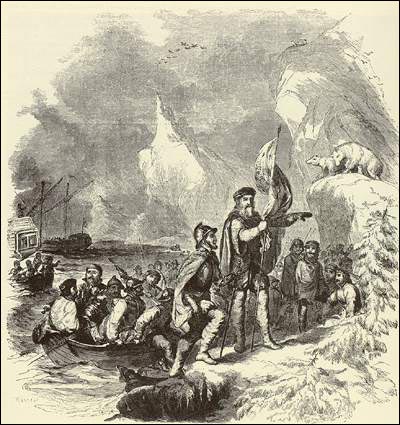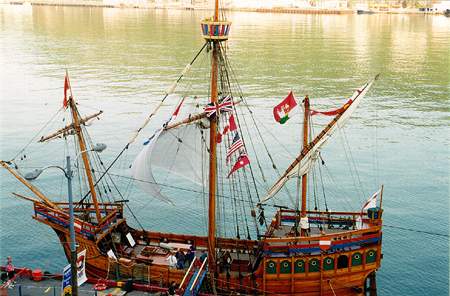Founding of Newfoundland and Cape Breton
There is very little precise contemporary information about the 1497 voyage. If Cabot kept a log, or made maps of his journey, they have disappeared. What we have as evidence is scanty: a few maps from the first part of the 16th century which appear to contain information obtained from Cabot, and some letters from non-participants reporting second-hand on what had occurred. As a result, there are many conflicting theories and opinions about what actually happened.

19th Century Interpretation of John Cabot’s Discovery of North America
Over the years, the exact location of John Cabot’s 1497 landfall has been a great subject of debate for scholars and historians.
“Discovery of North America, by John and Sebastian Cabot” drawn by A.S. Warren for Ballou’s Pictorial Drawing-Room Companion, April 7, 1855. From Charles de Volpi, Newfoundland: A pictorial Record (Sherbrooke, Quebec: Longman Canada Limited, ©1972) 1.
Cabot’s ship was named the Matthew, almost certainly after his wife Mattea. It was a navicula, meaning a relatively small vessel, of 50 toneles – able to carry 50 tons of wine or other cargo. It was decked, with a high sterncastle and three masts. The two forward masts carried square mainsails to propel the vessel forward. The rear mast was rigged with a lateen sail running in the same direction as the keel, which helped the vessel sail into the wind.

Modern-day Replica of John Cabot’s Ship, the Matthew
Although there is no contemporary 15th-century depiction of the Matthew this historical replica was built for the ‘Cabot 500’ anniversary celebrations in Newfoundland during the summer of 1997. This photo shows the Matthew during its call at St. John’s Harbour.
Reproduced by permission of Wayne Sturge. Photo ©1997.
There were about 20 people on board. Cabot, a Genoese barber(surgeon), a Burgundian, two Bristol merchants, and Bristol sailors. Whether any of Cabot’s sons were members of the crew cannot be verified.
The Matthew left Bristol sometime in May, 1497. Some scholars think it was early in the month, others towards the end. It is generally agreed that he would have sailed down the Bristol Channel, across to Ireland, and then north along the west coast of Ireland before turning out to sea.
But how far north did he go? Again, it is impossible to be certain. All one can say is that Cabot’s point of departure was somewhere between 51 and 54 degrees north latitude, with most modern scholars favouring a northerly location.
The next point of debate is how far Cabot might have drifted to the south during his crossing. Some scholars have argued that ocean currents and magnetic variations affecting his compass could have pulled Cabot far off course. Others think that Cabot could have held approximately to his latitude. In any event, some 35 days after leaving Bristol he sighted land, probably on 24 June. Where was the landfall?
Cabot was back in Bristol on 6 August, after a 15 day return crossing. This means that he explored the region for about a month.
Newfoundland Joining Canada
Newfoundland resisted joining Canada and was an independent dominion in the early 20th century. Fishing was always the dominant industry, but the economy collapsed in the Great Depression of the 1930s and the people voluntarily relinquished their independence to become a British colony again. Prosperity and self-confidence returned during the Second World War, and after intense debate the people voted to join Canada in 1949.
The “golden era” came in the early 20th century however the sudden collapse of the cod fishing industry was a terrific blow in the 1990s. The historic cultural and political tensions between British Protestants and Irish Catholics faded, and a new spirit of a unified Newfoundland identity has recently emerged through songs and popular culture.
